The State of Online Courses 2018 Report
Lexi Rodrigo
What’s it like to be an online course creator?
That’s the question we wanted to answer when we did the first State of Online Courses survey in 2015.
In the span of 3 surveys, we’re already seeing some shifts among course creators.
Here’s what we found in our latest survey of 707 online entrepreneurs:
Tl;dr (Too Long; Didn’t Read)
1. More respondents than ever before are creating online courses, and they’re becoming more mature:
- Fewer are still thinking about it and more are acting on their interest in online courses.
- Making money is less of a driving force for course creators than making a positive impact.
- Student satisfaction is their top criterion for what makes a course successful.
- Course creators tend to have businesses that are already bringing in revenue.
- Even before they finish their first course, aspiring course creators already recognize the primary importance of marketing.
2. Online course creators are still not meeting their enrolment and pricing goals. Enrolment fell while pricing slightly improved.
3. Course creators are confident that the majority of their students have been satisfied with their courses.
4. The majority of online course creators continue to rely on providing services to generate revenue from their business. Ideally, they would like to drastically reduce income from services and make up the difference with online courses and digital products.
5. Marketing continues to be the biggest challenge for both aspiring and current course creators, while technology has become slightly less of a concern.
It’s the Wild West for online course creation! The Mirasee report highlights how many entrepreneurs are conquering, dabbling in and exploring the online course arena. The range of successes and motivations means we still have a long way to go before predictability in the online course environment!
~ Vanessa Van Edwards, ScienceofPeople.com
[click_to_tweet tweet=”Marketing continues to be the biggest challenge for both aspiring and current course creators, while technology has become slightly less of a concern.” quote=”Marketing continues to be the biggest challenge for both aspiring and current course creators”]
Where Are They in their Course Creation Journey?
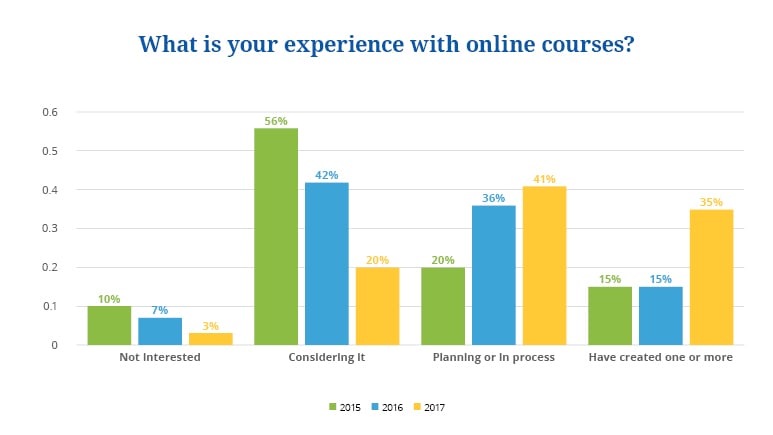
More survey respondents are acting on their interest in course creation.
There was a marked decrease in the percentages of respondents who are either not interested at all in online courses or are still thinking about it. Those who are planning, creating, or have created at least one course have all increased. The percentage of those who’ve created a course more than doubled within one year.
Why Do They Want to Create Online Courses?
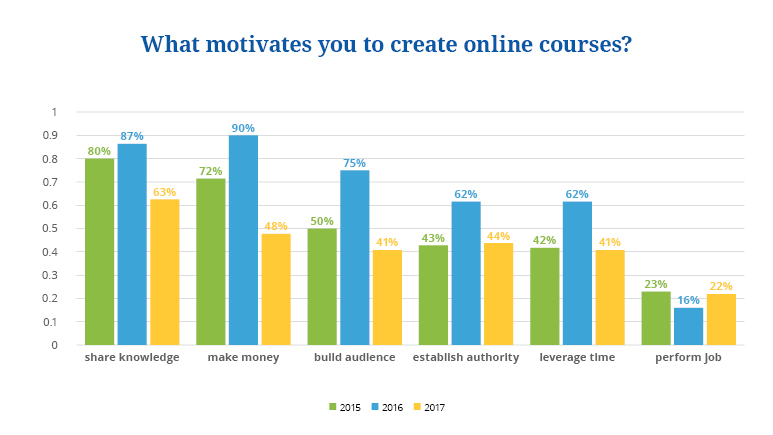
While making money used to be the primary driver for online course creators, in 2017 it was a far second to the desire to share knowledge. The desire to establish authority has also outpaced the appeal of building an audience and leveraging time.
[click_to_tweet tweet=”Making money used to be the primary driver for online course creators, but in 2017 it was a far second to this instead…” quote=”Making money used to be the primary driver for online course creators, but in 2017 it was a far second to this instead…”]
This, along with the fact that most respondents are already making an income, seems to indicate that online course creators tend to be experts in their field (i.e., they have knowledge to share) rather than people who are only looking to get rich quick online. We consider this to be one of the signs of a more mature industry.
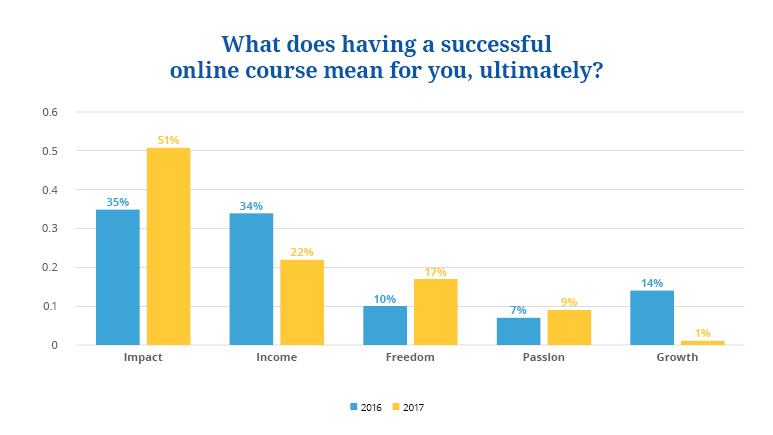
In terms of their “ultimate why,” more online course creators dramatically chose impact as the most important outcome of having a successful online course. Income is still important, of course, but less so than it was in 2016 when impact and income were about tied. The desire for freedom has increased. Only 10% of the respondents are in it for passion and growth.
Course Creation Success
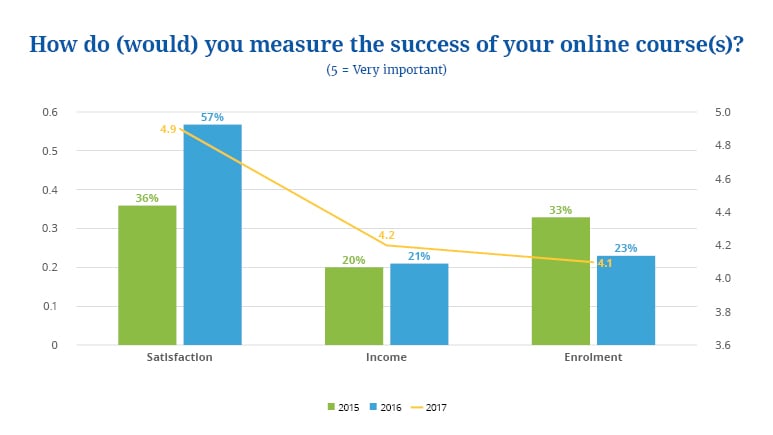
What does “success” look like to online course creators?
Student satisfaction remains the number one way course creators measure the success of their online course, followed by income.
Enrolment is the least important way creators measure the success of their course in 2017, although, in 2016, enrolment was more important than income.
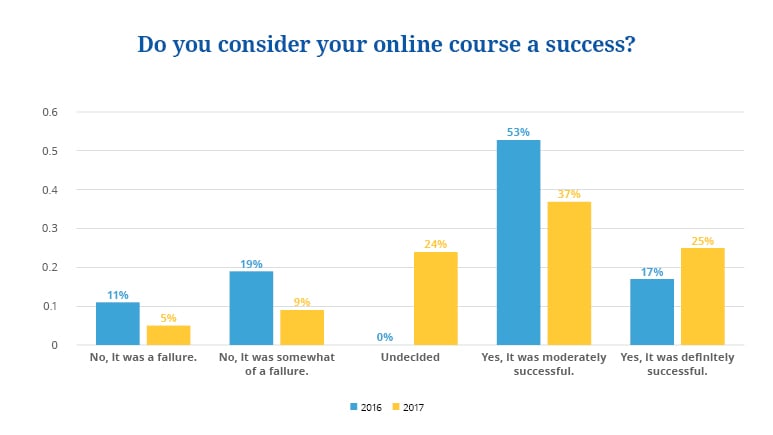
Given the chance to choose “Undecided” as an answer, a smaller percentage of respondents than before consider their courses successful—a full 24% felt undecided about it.
As expected, student satisfaction influences how respondents assess their course’s success. Among those who say their students are either satisfied or very satisfied, 70% judge their course to be successful.
On the other hand, if their students are unsatisfied—which was true for a very small number of respondents—they are likely to judge their course a failure. Interestingly, 24% of course creators whose students are neither here nor there in satisfaction still think their course was successful!
Course creators are more likely to say their course was successful if they charged a higher price. For example, 76% of those who charged $301-$499 and 100% of those who charged $500 or more say their course was successful.
The number of students enrolled also influences the course creator’s assessment of success. Only 49% of those with 1-20 students think their course was successful. In contrast, among those with 50+ students, the ratio who found their course successful is 82%.
Enrollment Numbers Declined
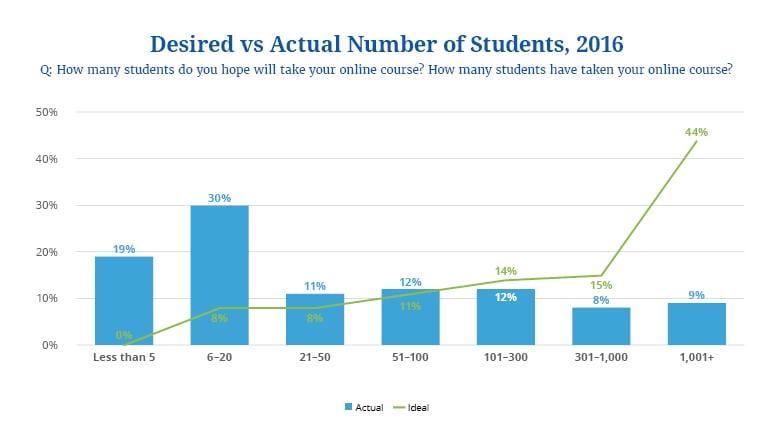
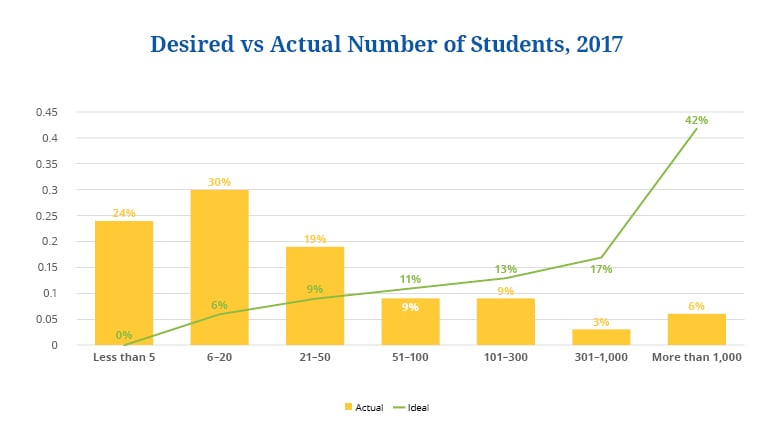
Enrolment seems to have dropped compared to 2016. Previously, 41% of respondents had 51+ students enroll in their course. In 2017, this dropped to only 27%. There was an increase in the percentage of creators who had less than 5 students and an even higher increase in those who had 21-50 students.
[click_to_tweet tweet=”A significant proportion of course creators aim for 1,000+ students, but the gap between what they hope for and what they achieve remains large.” quote=”A significant proportion of course creators aim for 1,000+ students, but the gap between what they hope for and what they achieve remains large.”]
A significant proportion of course creators aim for 1,000+ students, but the gap between what they hope for and what they achieve remains large.
This suggests the need to help course creators develop viable business models without needing to recruit hundreds of students. Whether that’s small-group programs with premium pricing, or using courses to drive sales of other services or other approaches. You just can’t feed your family on 20 students buying a $200 course!
~ Abe Crystal, Ph.D., Co-founder, Ruzuku
Pricing Improves Slightly

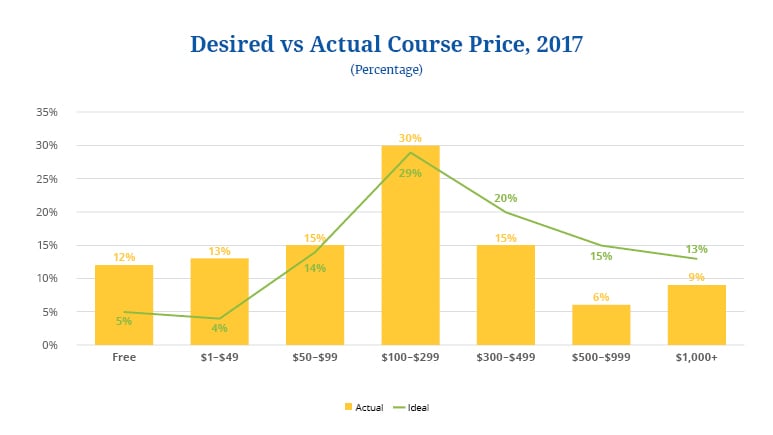
Course creators who want to charge $300 or more for their course continue to miss this goal. However, there are now two sweet spots for course prices: $50-$99 and $100-$299, where the percentage of creators who want to charge prices in these ranges are about equal to the percentage of those who do so. A smaller proportion of respondents are giving away their online courses (from 19% to 12%), and the ratio who charges $1000+ tripled (from 3% to 9%).
They also seem to be aiming higher. More respondents want to charge $500 or more for their course (from 21% in 2016 to 28% in 2017), and more of them are, in fact, doing so (from 12% to 15%).
Online Students Are Satisfied
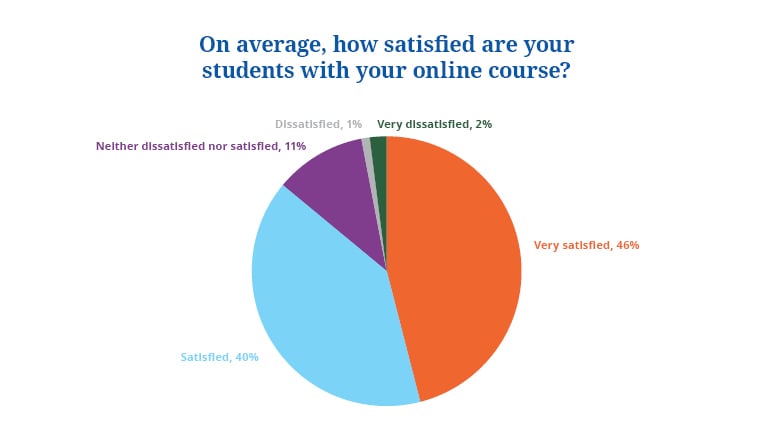
In terms of student satisfaction, course creators are doing very well. The majority of respondents (86%) are confident that their students were either satisfied or very satisfied with their course.
But how do they know?
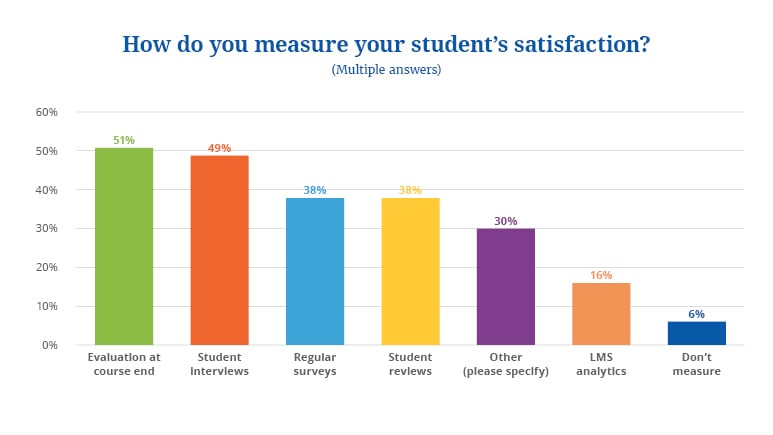
Course creators use a number of ways to measure student satisfaction: course-end evaluation, student interviews, surveys throughout the course, student reviews, other means, and LMS (learning management system) analytics.
The other ways they measure student satisfaction include “whether they take the next course in the series,” “asking for direct feedback via email,” and “feedback shared on Facebook.”
A small percentage of respondents (6%) don’t measure student satisfaction and success at all. Others try to do so but have difficulty getting answers. “I was quite disappointed that only 20% of participants gave me feedback,” said one respondent.
Some experts also point out the need to factor in the number of students who actually complete the course:
The satisfaction numbers seem super optimistic to me. This doesn’t feel in alignment with the number of students who actually TAKE a course when they buy it.
~ Sean Platt, Author and founder of Sterling & Stone
Some Are Just Not Into Courses
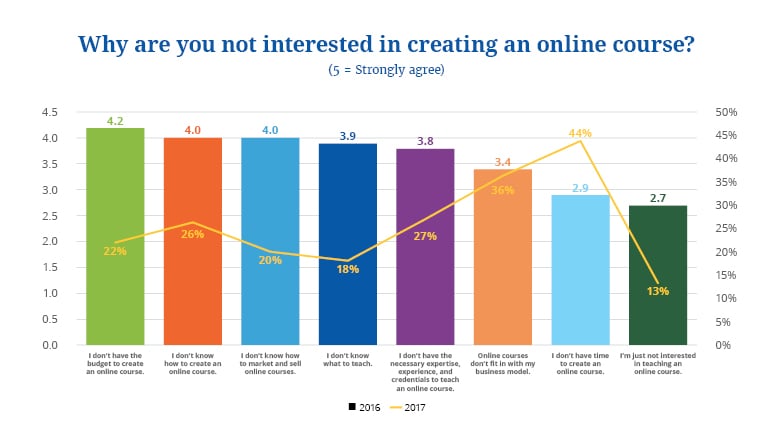
In 2016, time was the biggest factor that turned people off from considering online course creation. In 2017, the biggest obstacle was budget, followed very closely by the lack of course creation and marketing knowledge.
Let’s Talk Money
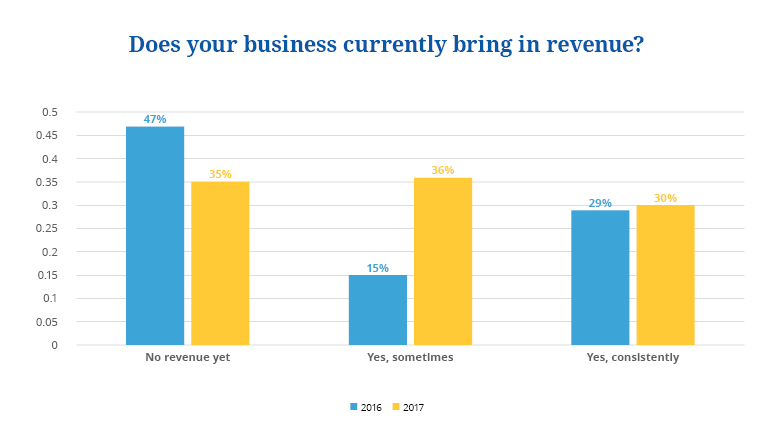
There was a marked increase in the percentage of respondents who have sporadic income. The proportion who make revenue consistently remained largely the same, while a smaller proportion of respondents don’t have any revenue yet.
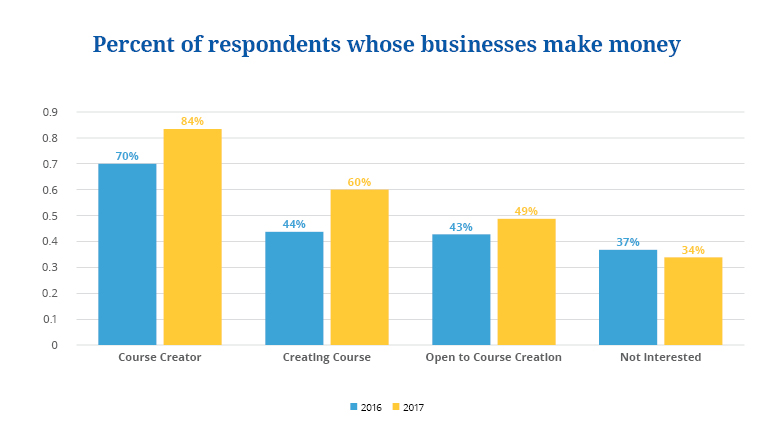
As in the past survey, those who have embarked on the course creation journey are more likely to be making money with their businesses, compared to those who are still considering it or are not interested in course creation at all.
A higher percentage of respondents who are on different stages of course creation is making money, whereas, among those who aren’t interested in course creation, a slightly lower percentage than before are making money from their business.
This could indicate that course creation attracts those whose businesses are fairly established and already earning some revenue.
Where’s the Revenue Coming From?
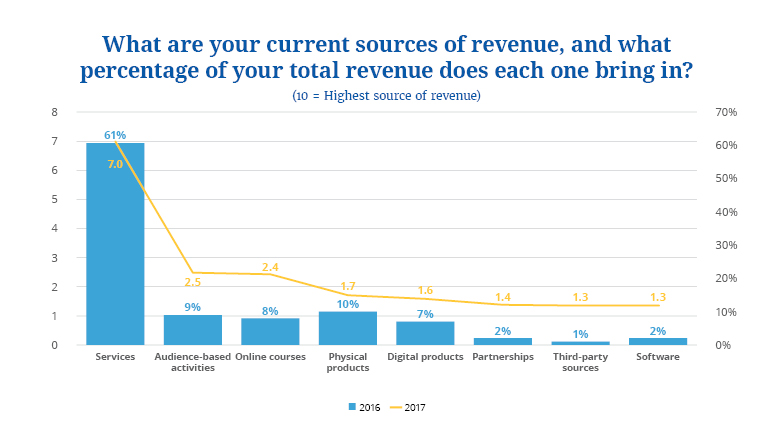
Compared to 2016, there was no change: the most significant source of revenue for the majority of respondents continues to be providing services.
Even though more respondents have created a course, online courses are still not a major revenue source for most. In 2016, 8% reported online courses as their single biggest source of revenue. In 2017, 8% of respondents get more than 70% of their income from online courses.
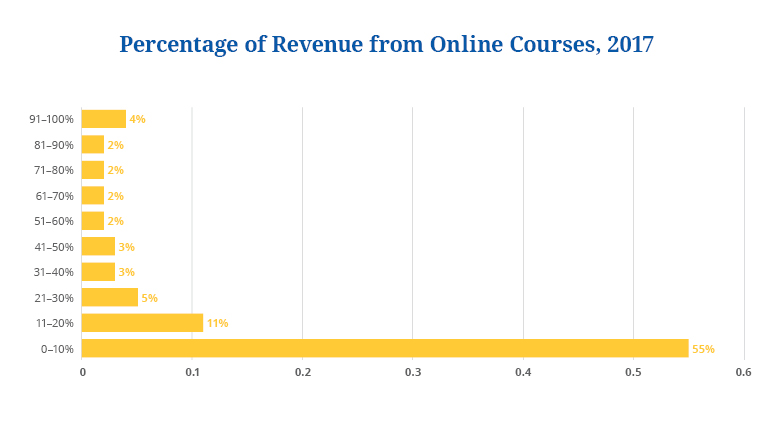
Where Revenue Growth Will Come From
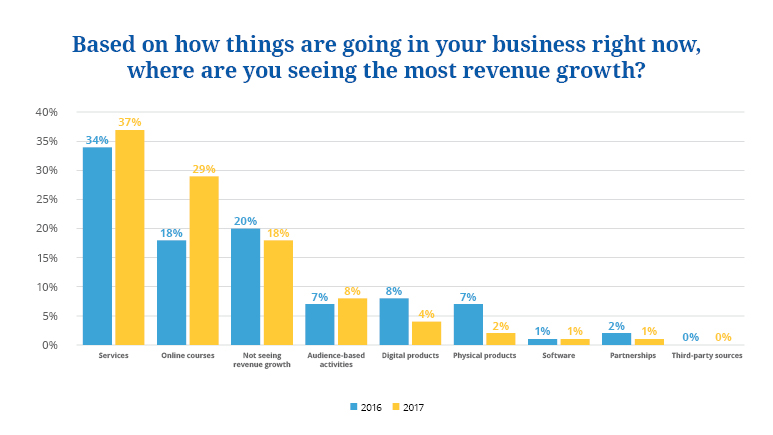
Respondents are noticeably more optimistic about online courses in 2017 than they used to be, with 29% seeing the most revenue growth from online courses, up from 18% in 2016. Course creators are most optimistic about seeing revenue growth from online courses (41%).
On the other hand, those who are creating their first online course (42%) and those who are still thinking about it (41%) expect revenue growth from providing services. An equal proportion (28%) of those who are not interested in online courses either see growth from services or no growth at all.
How They Would Rather Be Making Money
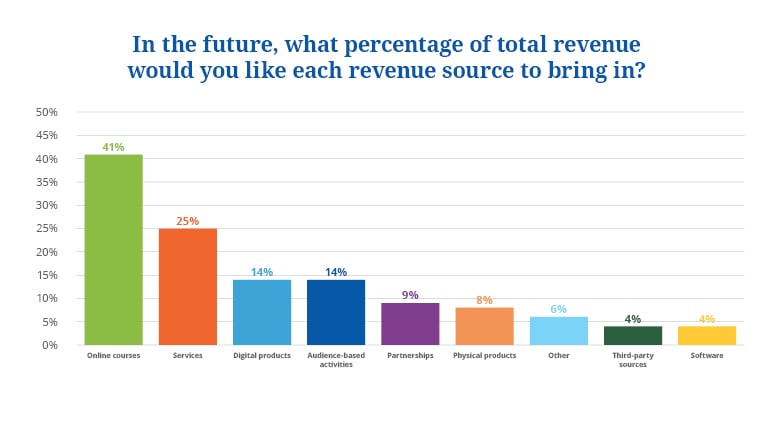
On average, respondents want to rely less on services and more on online courses for revenue. They would like almost half of revenue to come from online courses, only one-quarter from services, and the rest from digital products, audience-based activities, and others.
This is consistent with the previous year’s findings, where 52% of the respondents said they wanted online courses to be their greatest source of revenue.
Fortunately, business owners don’t have to choose one over the other:
All I see here is amazing opportunity! If you’re primarily service based there is such a huge opportunity to add more passive and scalable revenue streams driven by online courses. And you probably already have much of what you need in your service business to make the addition of courses much easier.
~ Greg Smith, B.Comm, Lawyer,
Co-Founder & CEO, Thinkific
How Can Online Course Creators Do Better?

Marketing and time continue to be the biggest hurdles for aspiring and course creators alike. Course creators ranked marketing a 4 (a big challenge) and time a 3 (a moderate challenge).
But for this batch of aspiring course creators, time is no longer the number 1 concern. They’re already looking ahead to the challenge of marketing their course—even before they’ve started creating it.
The marketing struggle leaves some course creators frustrated. Here’s what some of them expressed:
Now that I”ve created it, how do I market it?
~ Survey respondent
Marketing, marketing, marketing. I understand many of the things that seem to be effective in today’s world, however marketing is not my expertise or my genius work and I do not want to spend 90% + of my time on marketing. Unfortunately, this seems to be the time commitment necessary to be successful and that makes me seriously consider whether I will continue creating online courses. This is a shame because I have so many wonderful ideas for this platform.
~ Survey respondent
I followed all the instructions from a course I took on marketing an online course. I did it exactly, but sales were low. It is so hard to get down to the recommended # of people in FB. I have decided I need a professional to market for me for commission.
~ Survey respondent
Marketing is the biggie. Most online course marketing teachers know almost nothing about it and have little to no actionable info. I’ve only found one fab teacher/resource for this and everyone else is all hot air.
~ Survey respondent
Marketing is always the bugaboo, and if I don’t improve my capacity to reach and engage a larger audience all the great content in the world won’t help me retire.
~ Survey respondent
Technology is less of a problem overall. In 2016, technology was the second biggest challenge for course creators. In 2017, course creators think finding time is a bigger challenge than technology, which they now consider to be as challenging as the actual course creation. Aspiring course creators, for their part, have become slightly more concerned about course creation than technology.
This may be due to recent improvements in the growing number of learning management systems (LMS), course publishing platforms, and tools. They’re no longer accessible only to institutional course creators (such as schools and large companies), but also to independent course creators with limited technical skills and budgets.
Anecdotally, technology remains a huge stumbling block for many people, but these data suggest that tech is becoming easier to use and more democratized… which also means that leading-edge course creators need to be exploring new ways to differentiate their offerings.
~ Abe Crystal, Ph.D., Co-founder, Ruzuku
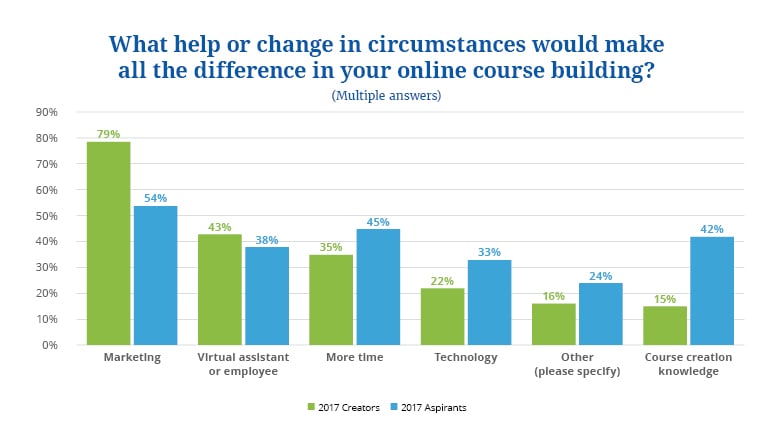
For both creators and aspirants, what would make the biggest difference is marketing help. Next, creators would like a VA or employee, followed by time. Aspiring course creators want more time and course creation knowledge more than an extra pair of hands.
Online Course Creation Today
The online course industry is attracting subject matter experts who want to share their knowledge and make a reasonable income doing so. Supported by businesses that are already bringing revenue, more of them are taking action and creating their courses. Eventually, they’d like to do less one-on-one business activities and more one-to-many approaches such as courses and digital products.
They’re slowly charging higher prices for their courses, but they’re struggling to fill the seats—they need and want serious help with marketing!
They seem to be doing well in terms of making their students happy, and this gives them the satisfaction that they’re creating a successful course… but they’re still far away from making lucrative courses.
They continue to rely on income as service providers, which leaves them with less time and energy to create and market their courses.
As one respondent commented: “I just already have a thriving busy business that is my income generator so it’s hard to put the course first.” This could become a vicious cycle unless they figure out a business model that eases the transition or integrates online courses in their service-based business.
Course creation should not only be looked at as a ‘product’ but also one of the most effective marketing tools at your disposal. For me, having a course has been instrumental in our marketing, as many clients now see us as the go-to service provider in our space. Another opportunity this seems to shine a light on, is that this spike in online courses is creating a need for a service that can market people’s online courses.
~ Josh Turner, Founder & CEO, LinkedSelling
Many see the opportunity in online course creation, but few are able to grab it—so far.
How about you? How’s your course creation going so far? Do these results reflect your own experiences, successes, and challenges? How is your situation similar or different?
Find a Sellable Topic for Your Online Course!
Get this primer and learn our process for identifying a viable topic for your very first online course.
Multichannelcreative
Very useful information. I like it.
Jacquelyn Johnston
Fascinating survey, covering aspects of course creation I had questions on. Thank you.
Lexi Rodrigo
@Jacquelyn – I’m glad you found the survey report useful. Thank you for your feedback!
John Lombaerde
Good information here Danny.
Btw – maybe you need to use a piece of software called Grammarly or another type of spell checking software. Enrolment [sic} has two l’s. (Enrollment). Keep up the good work. It is obvious quite a bit of effort went into this survey.
Kathryn Montgomery
I’ve yet to create my course and, thanks to this wonderfully comprehensive report, don’t feel *quite* as bad about that fact; I can see I’m in good company as I continue to believe I’m wrestling with ‘time’ as my greatest ‘opponent’! 😉 Key word: ‘believe’. Time to do a re-write on that one, methinks. 😉 Thanks for putting this together, Lexi — very, very helpful!